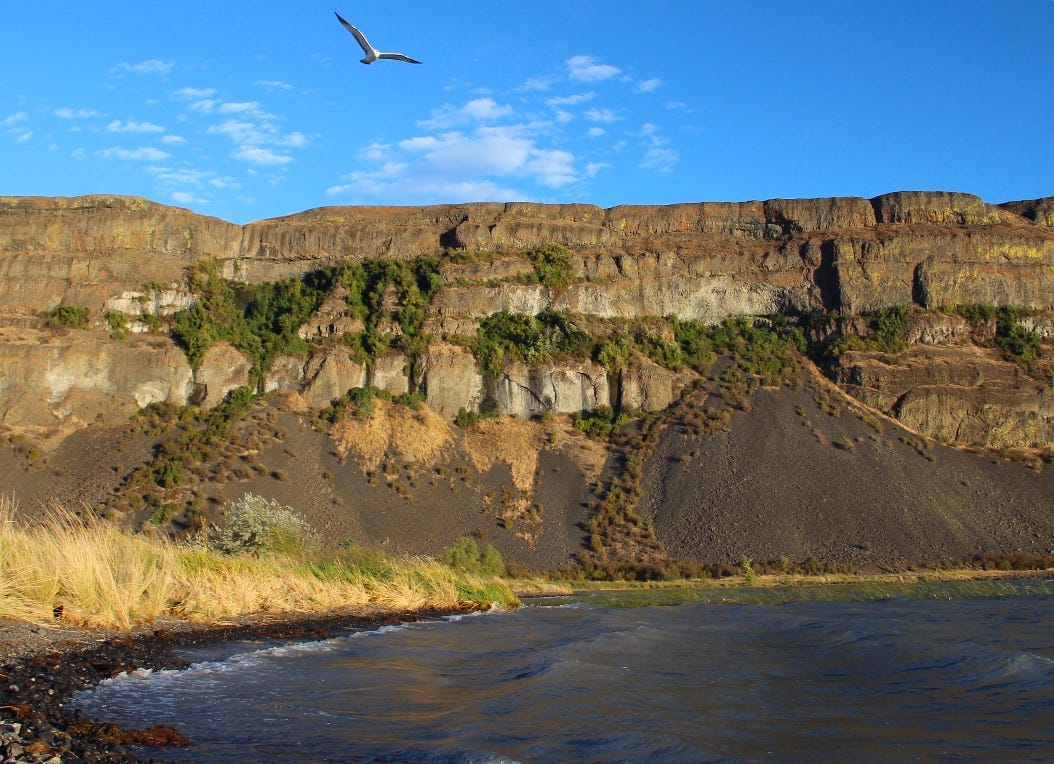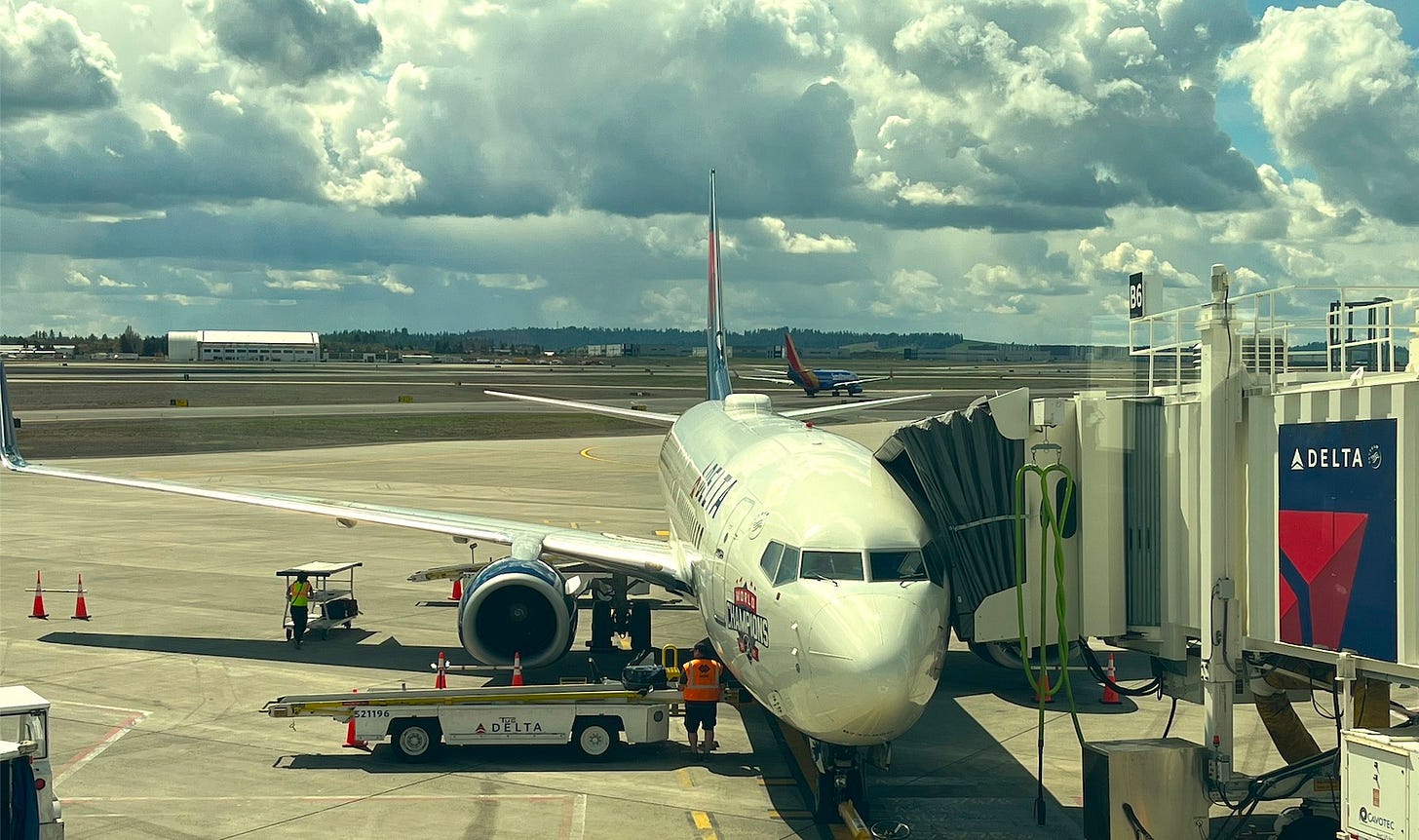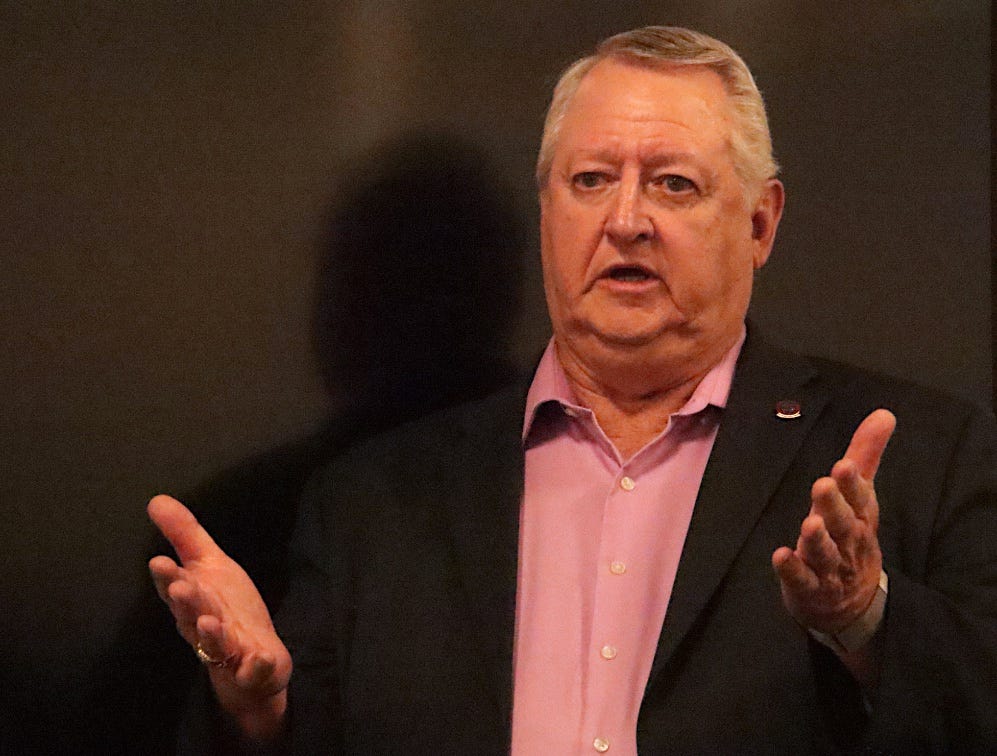Friday's postcard, and the Spokane airport (finally) hands its shoes to state regulators
May 10, 2024
Ring-billed Gull soaring above Grand Coulee
Finally…
Eighty-three months have passed since PFAS “forever chemicals” were detected in groundwater at Spokane International Airport (SIA). On this timeline—against the backdrop of a years-long cover-up and the airport’s ‘get-off-my-lawn’ blame-shifting —today is significant. For the first time, SIA representatives are meeting with state Department of Ecology officials to begin implementing a cleanup plan for the notorious PFAS water pollution, a task that will likely extend well beyond the nine square miles encompassed by the airport’s boundaries.
The welcome news that airport officials and contractors are now cooperating was delivered earlier this week at a packed community meeting in Airway Heights, just a couple miles from SIA’s runways.
Ecology’s Jeremy Schmidt fielding questions at Monday night’s public briefing in Airway Heights
The deliverer was Jeremy Schmidt the Washington Department of Ecology official who, since last July, has been the agency’s designated site manager for the airport cleanup. Schmidt and public outreach coordinator Erika Beresovoy co-hosted the Monday evening gathering. Though ostensibly an introductory public engagement session as part of a plodding process under Washington’s toxics cleanup law, the long delay in the reporting of the PFAS contamination at SIA has already forced state officials into a sort of toxics triage in response to public alarm and exasperation. Nobody from the airport was on hand, so it was left to Schmidt and Beresovoy and three other Ecology officials, including Brook Beeler, the agency’s Eastern Regional Office director, to field the inevitable tide of questions and concerns.
“I see a lot of familiar faces,” Beresovoy said with a tight smile and a warm voice as she looked out from behind a small lectern at more than a hundred faces looking back at her. “So that’s good, getting to know everyone.”
By way of background, both SIA and nearby Fairchild Air Force Base are sources of PFAS contamination in West Plains groundwater. There appear to be at least two different contamination plumes. Oddly enough the apparent boundary between the PFAS plumes is the deep and long “Airway Heights paleochannel,” that incises the basalt bedrock just to the east of Hayford Road. Hayford is a north-south thoroughfare whose unmistakable landmark is the sprawling Northern Quest Resort & Casino, four miles northeast of Fairchild and two miles northwest of SIA.
Whereas the Air Force moved relatively quickly in 2017 in response to the discovery of its PFAS groundwater contamination (providing clean water and offering treatment systems to those affected by the pollution west of Hayford Road) those with contaminated well water to the east of Hayford were left out. SIA’s failure to disclose its PFAS contamination is something the airport’s co-creators—the City of Spokane and Spokane County—have been slow to address, let alone explain. Into that void, Ecology, the state Department of Health, and the regional emergency response wing of the U.S. Environmental Protection Agency (EPA) have been racing to improvise interim responses well out ahead of the long-term benchmarks embedded in the state cleanup law.
One of the interim actions Ecology initiated earlier this year (in conjunction with EPA) was a plan to offer free PFAS testing for private well owners east of Hayford Road, in the pink-shaded area below.
When Ecology released the first results of the testing project May 1st the data confirmed fears that PFAS seepage from SIA may have spread for miles northward of the airport. Of just over 300 wells tested, 172 had detectable levels of PFAS above federal action levels. Ecology has begun delivering bottled water to those well owners with the high PFAS levels. The agency is also working with the state Department of Health to secure state grant funds for “point of use” water filtration that would remove PFAS from contaminated well water at individual taps and be available for eligible West Plains well owners presumably later this year.
As Schmidt methodically explained Monday night, the Spokane Airport is a liable party under the terms of Washington’s Model Toxics Control Act (MTCA). Under MTCA, SIA would be responsible not only for the cleanup of contaminated soils and groundwater at the airport, but for remedies needed to address off-site contamination if such contamination is linked to SIA pollution sources. Schmidt was blunt, at times, about the nature of the problem, not just the mobility of PFAS in groundwater but its longevity.
“When you start getting bottled water or treated water,” he told the audience, “you're going to be on bottled water and treated water likely for the rest of your lives. And that's a result of PFAS. It's terrible.”
While polluters pay under the MTCA legal framework, they’re only liable for remediation costs directly linked to contamination from their discharges, and that includes off-site remediation costs. But it can take years to complete investigations linking sources to off-site contamination.
At SIA, Schmidt said, the initial investigations and other work needed to complete a feasibility study for the SIA cleanup are scheduled to take two years.
Jetway at SIA’s main terminal
Whether and how much SIA may ultimately pay for the cleanup is an open question. Schmidt told me Monday evening the state will soon be invoicing the airport for approximately $70,000 in expenses Ecology has incurred, thus far, as it has worked to reach a negotiated cleanup agreement with SIA. Schmidt said he fully expects Ecology to be reimbursed. Still, the airport cleanup could plausibly cost millions of dollars and it remains an open question as to how much of the ultimate costs will be paid by SIA or the federal government.
In March, SIA informed Ecology that an “assessment” from the Federal Aviation Administration (FAA) persuaded SIA that the state’s cleanup order was likely illegal. But that position seems to have collapsed after the disclosure of a March 29th letter to SIA from Warren Ferrell, a Seattle-based FAA manager in which Ferrell opined: “In general, there is no bar on an airport using its own revenue to discharge its legal liabilities or to settle cases even where liability has yet to be adjudged.” In addition to cleanup costs, SIA would face that assessment of stiff fines from the state for non-compliance with a state order. The Ecology enforcement order was issued on March 29th, the same day as Ferrell’s letter.
Please support The Daily Rhubarb with a paid subscription
Calling Al French…
Of late, the only visible spokesperson for SIA has been Spokane County Commissioner and long-time SIA board member Al French. French’s commission district encompasses the West Plains and both airports. Now in his fourth term as a county commissioner, French recently announced his run for a fifth term. He does so in the shadow of lingering questions, including accusations he obstructed a state-funded study to better assess the extent of PFAS contamination in wells near SIA. There is also the question of when he first learned of contamination detected in SIA groundwater monitoring wells. He has cited possible litigation as a reason to avoid answering such questions.
County Commissioner and SIA board member Al French answering questions about airport PFAS at an April 11th meeting.
“I'll answer any question you have,” he told an audience on April 23rd, “except anything that involves the potential litigation and some of the other disputes that are going on. I want to stay focused on where we're going, not where we've been.”
As public alarm over the PFAS problem has gathered steam this spring, French has sought to get out ahead of the controversy by proposing a bold scheme to pump 8 million gallons a day from a shoreline well on the Spokane River up the West Plains. The water would then be distributed by a sprawling network of subsurface pipes to residences and farms whose wells have been contaminated by PFAS.
“My time frame is to have this done by next summer for all of you,” he told his audience.
When he opened his meeting with constituents on April 23rd French did so with a short Powerpoint presentation that included quoted endorsements from a “legislative aide to Congresswoman McMorris Rodgers” and a “Comment from EPA Region 10 Director” purporting to say "This is the kind of out-of-the box thinking that will lead us to a solution.”
When I asked EPA’s communication staff in Seattle to corroborate the purported endorsement, they sent me the following reply: “Regional Administrator (Casey) Sixkiller was not presented with a formal or informal proposal by Commissioner French. Rather he expressed support for the creativity the multiple parties have used to address the problems in West Plains and Airway Heights, including EPA’s unique use of emergency response funds to quickly sample West Plains wells.”
French’s bold, water-piping proposal was met with a smattering of derisive laughter when he offered it on April 23rd. It met a similar response from the crowd when it came up at Monday’s meeting in Airway Heights. Schmidt briefly noted he hadn’t seen a proposal like the one French had presented but then asked “our regional director” (Brook Beeler) if she had anything to add.
“I can't account for what he [French] may have said in that public meeting,” Beeler said, “but I can tell you it would be a very long time. There are a lot of barriers associated with it. We have not seen a plan but he's trying to be creative and we are certainly willing to listen.”
—tjc












